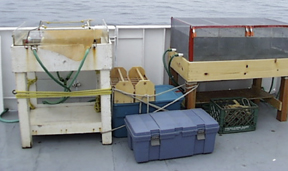

Dr. David Nelson's Cruise |
||
The first research cruise that the students followed in the 2005 school year was the Nelson Cruise which studied plankton and their effect on CO2 in the atmosphere in a seawater upwelling zone near the equator. The teacher, Mrs. Brice, participated in this cruise from Honolulu, Hawaii to San Diego, California (see map below). She stayed in contact with her students via satellite explaining the research being conducted to her students, answered their questions, assisted in their related lessons, and sent photographs. The students also participated in live at-sea, two-way discussion broadcasts with Mrs. Brice and ship-board scientists.
|
||
|
|
|
|
|
| The Science Party | ||
 Water Sampling Equipment
|
Chief Scientist, Dr. David Nelson Dr. William Balch Dr. Stephen B. Baines Dr. Mark Brzezinski Dr. Fei Chai Dr. Richard Dugdale Dr. Richard A. Feely Dr. Michael Landry Dr. Christopher Measures Dr. Paul Treguer Dr. Benjamin Twining Dr. Francis Wilkerson |
|
Lowering the CTD into the water to collect |
||
|
||